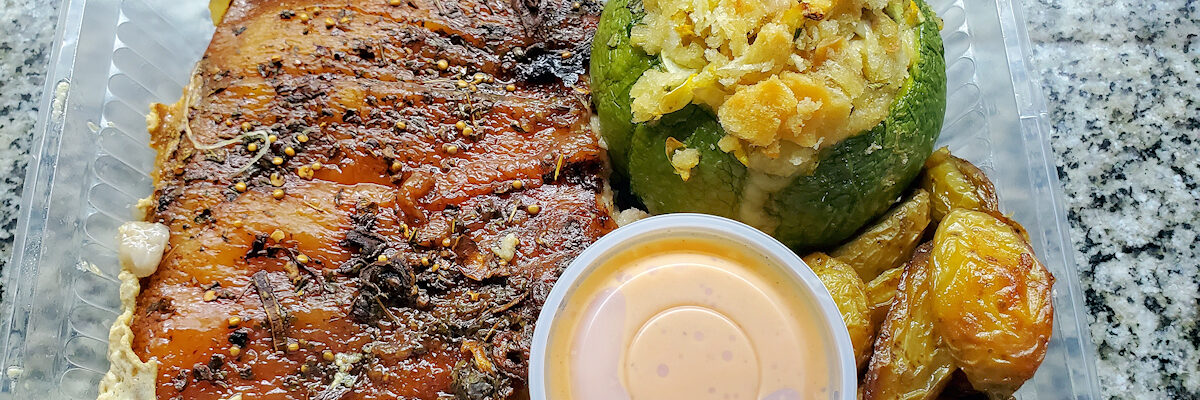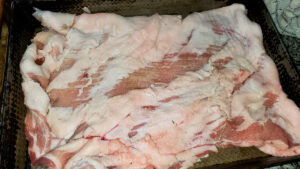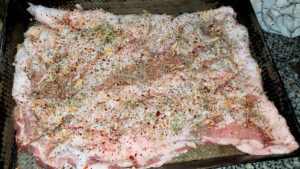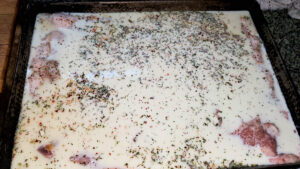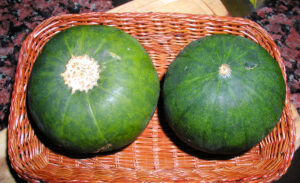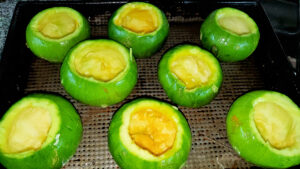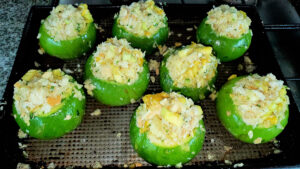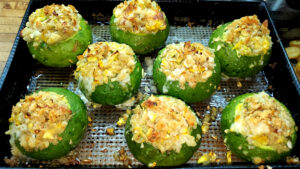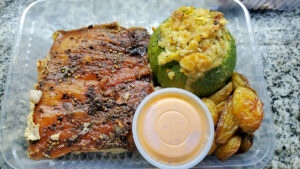I’m going straight to the food this time, since I gave you a quarantine update just two days ago. So let’s start with the question I often get asked when talking about this cut of pork, matambrito, just what is it? The best translation I could give you is something along the lines of a sort of “pork brisket” or “pork flank” if those existed as named cuts in English. In looking at different diagrams of where it’s cut from, it’s essentially the side flanks of pork belly as they go up to the mid-sides of the pig. In some diagrams I’ve seen it labeled as “side bacon” – and maybe that’s the best we can delimit it.
This is what a matambrito looks like. I’ve already trimmed off a fair amount of excess fat. We want to leave some, actually a good amount, because just like pork belly, it’s part of what makes this really delicious when it’s slow cooked. A lot of that fat will melt away, as you’ll see. So I’ve laid it out in a baking pan. One like this weighs in at about a kilo and a quarter, which, after cooking down and rendering out that fat will leave me with four good portions, each weighing a little under a quarter kilo, or 8oz.
Then I give it a good spice rub and let it sit for a couple of hours. This is a mix of salt, pepper, chili flakes, mustard seeds, oregano, thyme, basil, parsley, and garlic and onion “bits” (finely chopped, dried, and toasted). You could also use finely chopped fresh garlic and onion – I’ve done it both ways, it pretty much comes out the same. And, you can vary the spices and herbs to your heart’s content.
After it sits for awhile, I add a bottle of beer (they’re like 330ml, or 11oz here) and a liter of milk (34 oz, just over a quart, but a quart is fine, this isn’t a science experiment). The lactic acid in the milk helps tenderize the pork as it cooks, and the proteins in the milk give the whole dish a richness and the sugars in the milk caramelize – it’s almost like making dulce de leche without sugar as a coating for the pork. I put it in a medium heat oven – 150°C/300°F. Then, basically, walk away for the next five or six hours. I check on it now and then, but really, there’s nothing to do.
Now, I forgot to take a photo of the whole thing, and very bizarrely, I’ve gone back and checked my photo files for the last fifteen years of cooking here in Argentina, and I seem to have always forgotten to take a photo of the whole thing when it comes out of the oven. So you’ll have to be content with the photo at the top of the post and down below, of it already cut into a portion. But that’s what you’re looking for, a deep, rich, caramelized surface, and, after five or six hours in the oven, the meat is just falling apart tender.
Next, our guarnición, or accompaniments. These are zapallitos, or, globe zucchini, eight-ball zucchini, or sometimes globe squash or eight-ball squash. I’ve talked about them before, and even did a brief look at them during the first month I lived here (in fact, this photo is from then). We’re going to stuff them, one of my favorite ways to prepare them, and a classic of Argentine cooking.
Sometimes I cut them in half and then have two much wider open receptacles for stuffing, but I wanted the presentation of a whole one for this dish. So I made a very thin cut on the bottom, just to remove the little point and allow them to sit flat. Then I sliced off the top stem leaving an opening big enough to dive into, and scooped out all the flesh and seeds. A light coating of olive oil in the pan helps prevent these from sticking and burning.
I chopped up the meat of the zappalitos, then mixed that with some fresh breadcrumbs (some people prefer dried ones, I’m mixed on that – you get a different texture, but both are good). A fresh, soft cheese, torn into bits, something like Port Salut, Cuartirolo, Mozzarella. hell, although I’ll take flack for this from foodie and chef friends, this would be brilliant with Velveeta. Also lots of chopped garlic, some fresh herbs – in this case parsley and chives. Some salt and pepper, and a bit of olive oil. Mix it up well, and put in a hot oven for 45-50 minutes. I cooked these and the oven roasted new potatoes – parboiled, chilled, cut in half, tossed with olive oil and salt, and roasted while the matambrito was in its dry rub, then turned the oven down to cook that.
And, they come out beautiful and golden brown. The whole thing is edible, shell and all.
And, our final dish, as sent out to customers. A nice portion of the matambrito, you can see how beautifully caramelized it is. A zapallito relleno, or stuffed zapallito, some of the potatoes, and a little quickly blended and emulsified tomato vinaigrette for the pork – into the blender with a whole tomato, a clove of garlic, a shallot or half a small red onion, a good pinch of dried thyme, a couple of tablespoons of red wine vinegar, a teaspoon each of sugar and salt, and half a teaspoon of white pepper – blend it all together and while blending, gradually drip in a neutral oil (you could use olive oil, I don’t for this, because it gives a different flavor, the tomato doesn’t shine through as well), until it’s emulsified – about the consistency of a slightly runny mayonnaise. For those of you into the modernist cooking world, you could emulsify this with a small amount of xanthan gum just to give it that holding power.
